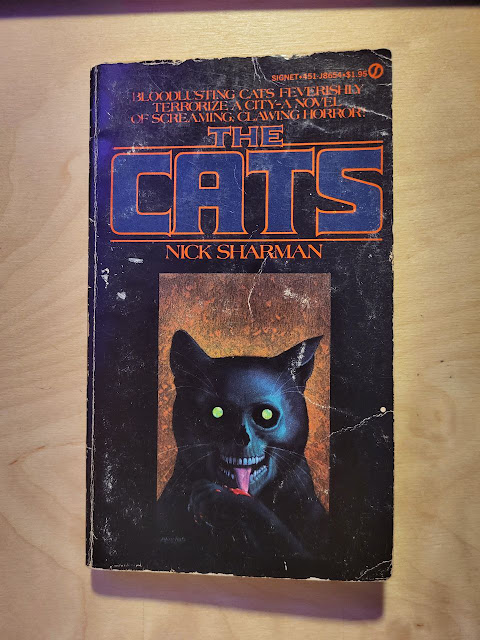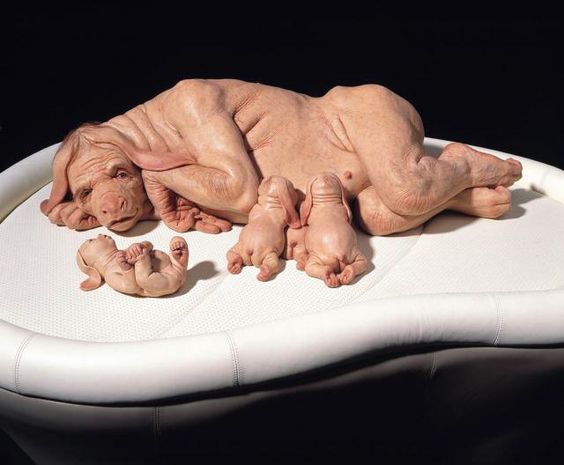Reading: The Cats by Nick Sharman
Some years ago I thrifted a load of pulp horror and SF/F paperbacks in Idaho while visiting family. The Cats by Nick Sharman (an alias for Scott Grønmark) is a book I picked up based on the cover alone- the old adage about judging a book by its cover be damned, I love a cool illustration on a book cover. I will always buy editions of books with the best possible cover art.
This shit is like catnip to me, pun intended.
The book cover for The Cats is by none other than Don Ivan Punchatz, the illustrator perhaps best known for his iconic Doom box art. A fun fact is that his son Gregor Punchatz worked on the monster models for Doom as well. In Don's prolific career he also illustrated for Heavy Metal, National Lampoon, Playboy, Time, as well as cover illustrations for Isaac Asimov and Harlan Ellison novels.
Appropriately enough, here's a photo of Punchatz with a cat.
As for the novel itself, I'll start off by saying it's not high art, but it's an enjoyable pulp read. The premise is a fun mix of silly and scary- what if common housecats turned against us? In a lot of ways, it's hard to take an idea like this seriously, imagining cats as scary is kind of hard to do, especially if you own cats and know what utterly goofy little guys they are. Even though I know well enough that a cat can seriously injure me, it's just not something that registers as scary. On the other hand, the unique feeling of betrayal it stirs up is sort of frightening, along with the notion of having to fight and kill a once-beloved pet gone mad. The 70s was a time of a lot of animal vs man horror (sometimes as a subset of eco-horror) and this is a solid entry to the genre, following in the footsteps of 1974's The Rats by James Herbert.
The story begins with a young American man living in the UK, who we learn is on the run from his politician father and is running some kind of animal experiment. The American, Inglis, is going to visit an old professor of his to tell him about the microbiology research he's conducting, which is based on the professor's own previous work. In the American's apartment, a young boy named Mark is tasked with attending to his lab animals, a bunch of cats who are infected with a pathogen. The boy accidentally knocks over a cage and releases a cat, then becomes mysteriously compelled to release all the other cats from their cages. Inglis' professor, Vole, is horrified to learn what his former student is up to, and reveals that he'd been working for the government in biowarfare and stopped his experiments on moral grounds. Inglis has followed the same research, which was never supposed to see the light of day. We learn too, that the pathogen is not only highly contagious among cats- to violent and deadly results- but can sometimes infect people.
At the same time, London is also experiencing an abnormal heat wave, and it turns out that this is a deadly catalyst for the pathogen that the cats are infected with. And boy, doesn't that feel oddly relevant right now at a time where climate change is bringing record temperatures to countries that are not equipped to handle them.
The boy tasked with caring for the lab cats happens to be a politician's son, the UK's minister of education, and it's at the estate of said minister that the first cat attack occurs. A group of cats gangs up on a guard dog and brutally kills it. There's a bit of weird backstory here about the minister, Dempsey, running afoul of the IRA and therefore needing a guard dog and security on hand, so the incident of the dog death is initially met with pretty serious police attention. The attending officer, Crowther, becomes a main character as the disastrous events of the book unfold. We also learn that Dempsey's infected son has a link with the cats and starts acting alongside them.
There's a pretty fun and satisfying scene where Mark leads his school bullies into a feline deathtrap- though the whole situation does read as a strange condemnation on public schools. There's a bit about Dempsey being a socialist (?) and being a hypocrite for sending his son to private school while being the minister of education, so in response he'd had Mark put into public school where the child is bullied mercilessly for being sickly and a politician's kid. Granted, school children are vicious and bullying can happen anywhere, but don't we typically hear more horror stories from rich private schools (especially all boy's boarding schools) in the UK? That aside, Mark's perspective among his new murderous cat friends is entertaining and I would honestly read a whole book that's based on that perspective specifically, revenge plot included.
The Cats does have a reactionary bent through-out. As the cat attacks progress, we get little vignettes of different victims who meet their end at the paws and claws of the feline foes. It's in these descriptions that we get some weird views on society from the author. A petty drug dealer living in a squat (who'd previously sold drugs to children) is murdered by cats while tripping on LSD. The author mentions how the dealer received government money for living in a squat and that the UK was the ideal place for him. This kind of thing happens again with a petty thief and would-be rapist, who's backstory details the fact that he is jobless and happily living off unemployment and thievery. Sharman really hates social programs, from the sound of it. There's also an off-putting occurrence of yucky racial stereotypes, first in the appearance of an "Arab" who is visiting a prostitute (both described in a deeply unflattering fashion) and then again a mention of an Arab businessman who's suggested to be a pedophile- inviting "young boys" to his hotel room. It feels a shame that an otherwise pretty silly and benign horror novel has to detour into a rant about the corrupting influence of socialists and foreigners.
If you can move past these embarrassingly conservative moments in the book, the rest of the events are pretty exciting and even scary and harrowing. The cats amass into a veritable plague and London becomes quite helpless in defending itself from the sheer volume of ravenous and strangely organized animals. The idea that a pathogen (referred to as a bacterium in the book but never identified in specific- perhaps inspired by toxoplasmosis?) can make cats both violent and weirdly intelligent is silly, but the result is still quite gruesome. No one- not even infants and children- is spared in the chaos that unfolds. The writing style is gripping and has a nice flow to it, descriptive and punchy. I do think the pacing works quite well too.
In addition to the killer cats, another theme of the book is "shitty fathers who are politicians." Both Inglis' senator father and Mark's minister of education father are image-obsessed men who put their own careers before their children's wellbeing, and really it's their actions that kick off the whole unfortunate chain of events. I did enjoy this aspect and thought it added an interesting dimension to what would otherwise be a fairly standard man vs nature story. Both fathers end up regretting their actions and trying to reconnect and be better to their sons, but it's a case of too little and too late. I'm not saying there's depth to it, but it's at least something extra to chew on.
I'm a bit mixed on the book overall. I had fun and enjoyed reading it- it's a breezy trashy read you can polish off in an evening or two- but the political undertones leave a bad taste in my mouth. Would I recommend it? Not particularly.
I'll note that Sharman, aka Scott Grønmark, passed away in 2020. He was active as a writer for many years and was a blogger when he retired. One of his last blog entries is in praise of the utterly dogshit sounding book Woke: A Guide to Social Justice by Titania McGrath, so we can safely say that the author's reactionary tendencies in 1977 did not lessen over the decades. RIP I guess.



.png)


Comments
Post a Comment